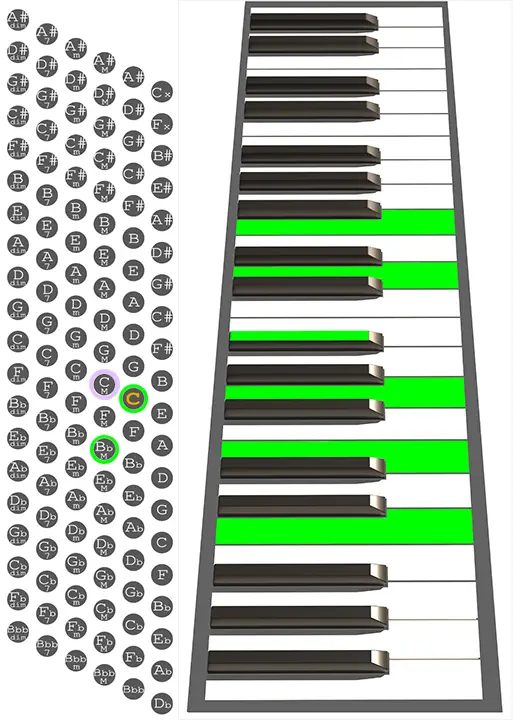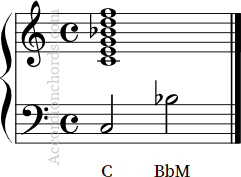AKA: C7/9/11, C9(11), C9/11, C Dominant 11th, C Dominant 7th/9th/11th, C Dominant eleventh, C Dominant ninth eleventh, C Dominant seventh ninth eleventh
C11 Accordion Chord Chart

11th Chords
An 11th chord is a chord that includes the root note, the major 3rd, the perfect 5th, the minor 7th, the major 9th, and the perfect 11th.
In terms of music theory, 11th chords are considered to be extended chords because they include notes that go beyond the seventh degree of the scale. They are typically constructed by adding the 11th degree to a dominant 9th chord, which creates a rich, complex sound that is often used in many styles of music.
C11: In-depth analysis
For a detailed exploration of the C11 chord, I recommend checking out my article “C11 Piano Chord – Charts, Harmony, and Music Theory” on ChordsAround.com
11th Chords on Accordion
On a standard bass accordion, you can play 11th chords by combining a root and its Major chord with the Major chord built on the minor 7th interval.
For example, you can play a C11 (C, E, G, Bb, D, F) combining C Major (C, E, G) with Bb Major (Bb, D, F). Some accordionists may opt for a simpler version that only includes the C and Bb Major chords, omitting the 3rd and 5th notes that don’t add tension to the chord. This is why on the bass chart, the chord button circled in purple is marked as optional.
By playing only the buttons circled in green, you have: Root, 7th, 9th, and 11th which can also be seen as a suspended chord (9sus4).
On the keyboard: an eleventh chord, in theory, has 6 notes, however, since your hand can play only 5 keys at once, you can omit either the root or the 3rd or the 5th with your right hand.

Notes:
C, E, G, B♭, D, F
Intervals:
R, 3°, 5°, m7°, 9°, 11°
Left hand:
C + B♭M
same as C9sus4
or
C + CM + B♭M
Fingering:
2 + 4
or
3 + 2 + 4
Your diagram shows six fingers on the right hand. Of course, when played with a C in the bass, you won’t need the c in the treble. Perhaps a discussion of chords in root position and then in inversions might also be a helpful addition to be read before getting into the individual chords.
Sure! You’re right, especially in this case, it would be helpful adding some extra info. I’ve added 6 notes on the keyboard to show intervals but it may result confusing. Thank you for your suggestion!